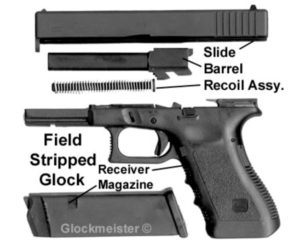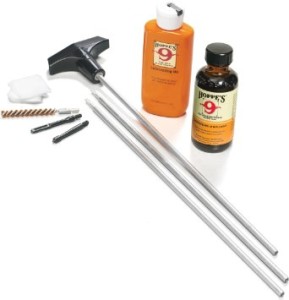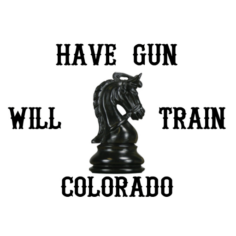Firearm Cleaning
Safely Unload Your Handgun
1. Make sure to remove all ammunition from the area, ideally to another room, while cleaning your handgun.
2. Handle your firearm safely. Always keep the muzzle pointed in a safe direction, treat the firearm as if it is loaded. Keep your fingers off the trigger.
3. Eject the magazine.
4. Empty the chamber. Pull the slide back. Visually and physically inspect for any remaining cartridges. Remember to feel with your finger, not just look.
 Field Strip the Handgun
Field Strip the Handgun
1. Dismantle the firearm safely. Most modern handguns make this a relatively simple process. The actual process may vary greatly depending on the model of handgun. Check your owners manual.
 Clean the Handgun
Clean the Handgun
1. Assemble your equipment. (solvent, patches, cleaning rods, toothbrush, oils and lubricants and rags, and qtips)
2. Wipe down all components using a clean soft rag. Precision is not required during this step.
a) Wipe quickly, removing as much of the debris, old oil, grease, unburned gunpowder, and carbon buildup created from the use of the handgun as you can.
b) Include the inside of the magazine well, the injector, guide rails, and the area around the chamber.
c) You will find certain areas turn the rag black, clean as well as you can.
3. Appling solvent.
a) Most handgun manufacturers design components, even the polymer, to be safe when using solvent. Check for manufacturer warnings.
b) Apply a modest amount of solvent to all parts twice.
c) Make sure to apply solvent to any area with dirt, carbon buildup, or unburned powder.
d) Let the solvent sit for a couple of minutes and soak.
e) Scrub the areas on the handgun with solvent using a toothbrush. This works in the solvent and loosens the build-up on the gun.
f) You can use the dental pick to remove any pieces of carbon and gunpowder build-up remaining in the tight parts of the handgun.
g) Use a bore brush to break up any buildup free from the barrel. Run the brush the full range of the barrel at least five times. Be sure not to reverse directions with a brush in the barrel instead push it all the way through, letting the bristles change direction outside the barrel. Then bring the brush back in the opposite direction.
h) Swab the barrel with a patch soaked with solvent. Repeat until the patch remains relatively clean.
i) Wipe the gun with a clean lint-free cloth. Continue to wipe until you remove all of the solvents.
j) Wipe down the whole gun inside and out with a lint-free lightly solvent-soaked cloth. Look for any areas that turn the cloth dark. Clean these areas again.
Lubrication
The next step in the process is proper lubrication of the handgun. Lubrication is essential to keep your handgun from malfunctioning. The main goals are the prevention of wear and corrosion.
1. Oil all metal components requiring lubrication. Often the gun’s manual specifies areas to oil. Look for areas of wear; this will indicate the need for oil.
a) You can use a small paintbrush with a couple of drops of oil on the bristles to apply a minimum amount of oil.
b) Use a clean patch with a couple of drops of oil, to swab the barrel inside with oil.
c) Apply oil just thick enough to leave a distinctive fingerprint when a part is touched.
d) Be sure to oil the areas around all rotating parts, such as the base of the hammer or trigger assembly.
e) Try to keep oil away from the openings into the firing pin housing. Oil is a collector of dirt and powder buildup, which can cause your firing pin not to fire.
2. Lightly grease all sliding parts. Well-known gunsmiths are recommending the use of grease, especially on the frame rails of automatic handguns. Grease is better on sliding parts since these parts tend to shed oil quickly.
a) Using a cotton swab, grease the guide rails on the frame.
b) You can use the same cotton swab to apply grease to the grooves on the slide.
Reassemble the Handgun
1. Reassemble the handgun.
2. Make sure all parts are functioning properly.
a) A quick test for proper functioning is to rack the slide; make sure the slide returns complete into the battery (all the way forward). If the slide does not return properly the recoils spring may not be set properly.
b) Making sure the handgun is unloaded (see the safety section). Pull the trigger. You should hear a click. Rack the gun again.
c) If the gun is not functioning properly, field strip the handgun again and reassemble it until it functions properly.
3. Wipe down the entire handgun and remove any excess oil.
4. Immediately before you intend to start shooting, swab the barrel with a dry cloth to remove any residue.
